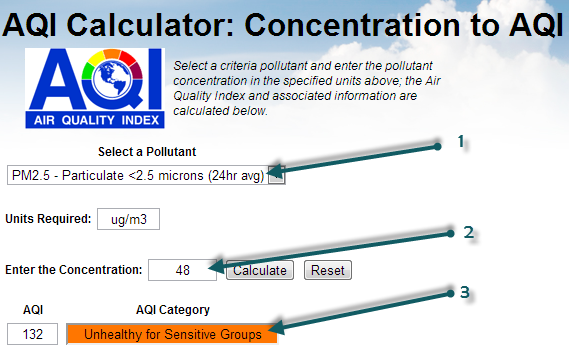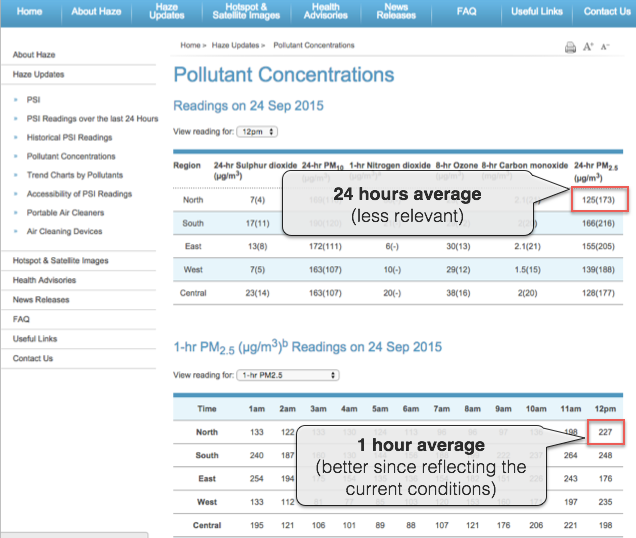In April 2014, the Singapore NEA has updated the PSI calculation to also include PM2.5. http://www.nea.gov.sg/anti-pollution-radiation-protection/air-pollution-control/psi
With the recent Southeast Asia Smog from Indonesia affecting Singapore and now Malaysia, we got many questions about why there is a difference between the data which can be read from Singapore NEA website (nea.gov.sg) and the World Air Quality Index project Singapore webpage.
مثال کے طور پر، یہ ہے جو آج NEA کی ویب سائٹ پر پڑھا جا سکتا ہے:

کچھ تاریخی وجوہات کی بنا پر، سنگاپور ہوا کے معیار کا جائزہ لینے کے لیے PSI ( Polutant Standard Index ) استعمال کر رہا ہے۔ اوپر کی تصویر میں، نمبر 1 PM10 کی قیمت سے مساوی ہے جو PSI کی تشخیص کے لیے استعمال ہوتی ہے۔ قدر 67(/59) 67 μg/m3 کے طور پر پڑھا جا سکتا ہے، جو کہ 59 کے PSI کے مساوی ہے۔ PSI کا اندازہ ہر ایک آلودگی کے لیے انفرادی PSI کی زیادہ سے زیادہ کے طور پر کیا جاتا ہے: PM 10 , SO 2 , NO 2 , O 3 (اوزون) اور CO 2 ۔
PSI(Singapore-North) = max( PSIPM10-based, ... PSIO3-based )= max (59, ..., 77) = 77
اس نے کہا، دلچسپ بات یہ ہے کہ اسی جدول میں PM2.5 کا ڈیٹا بھی آخری کالم میں دیا گیا ہے (دیکھیں 3)۔ یہ ڈیٹا صرف μg/m3 میں فراہم کیا گیا ہے (2 دیکھیں)، اور PSI جیسی کسی چیز میں کوئی تبدیلی نہیں ہے (یعنی PM2.5 ماس سے آلودگی یا کوالٹی انڈیکس میں تبدیلی)۔ تاہم یہ تبدیلی موجود ہے، اور اس کی تعریف یو ایس انوائرمنٹل پروٹیکشن ایجنسی نے کی ہے۔ تبدیلی کرنے کا سب سے آسان طریقہ آن لائن کیلکولیٹر کا استعمال کرنا ہے، جو airnow.gov پر دستیاب ہے:

If you select the PM2.5 (1), then enter the mass concentration of 48 (2), can click on Calculate, you will obtain the AQI of 132 (3). So, based on the PM2.5 AQI conversion, the PSI that is used for Singapore could be extended (let's call it PSI++) to also take into account the PM2.5 information. In which case, the PSI++ would be the maximum of the regular PSI (based on PM10 only) and the PM2.5 AQI:
PSI++ = max( PSI, AQIPM.25 ) = max( 77, 132 ) = 132
This PSI++, that is commonly referred as AQI (or Air Quality Index), is what is being used on the the World Air Quality Index project, for all the cities (provided PM2.5 is available for the city). And this explains why the values are different between the NEA website and the World Air Quality Index project.
Moreover, when doing the convertion, make sure you use the 1-hour reading for the PM2.5 concentration rather than the 24-hours averaged value, as shown on the below image:

http://www.haze.gov.sg/haze-updates/pollutant-concentrations/type/PM25-1Hr
If you want to know more about PM10 vs PM2.5, and especially why PM10 is still used, please check the faq entry about why is PM2.5 often higher than PM10? Is PM10 still a relevant measure?
--
For more information about specific countries or continent, please refer to those articles: Thailand and Malysia - India - China - Hong Kong / Canada (Air Quality Health Index) - South America - Australia - Quebec and Montreal - Singapore - Poland - Indonesia .
For information about the 24 hours averaging used or Ozone and Particulate Matter (PM2.5), please refer to those two articles: Ground Ozone Index - PM2.5 Instant Cast
